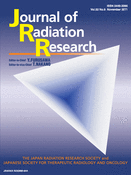-
PDF
- Split View
-
Views
-
Cite
Cite
Hiroaki Terato, Katsuyuki Suzuki, Nobuhiro Nishioka, Atsushi Okamoto, Yuka Shimazaki-Tokuyama, Yuko Inoue, Takeshi Saito, Characterization and Radio-resistant Function of Manganese Superoxide Dismutase of Rubrobacter radiotolerans, Journal of Radiation Research, Volume 52, Issue 6, November 2011, Pages 735–742, https://doi.org/10.1269/jrr.11105
Close - Share Icon Share
Abstract
Rubrobacter radiotolerans is the most radio-resistant eubacterium without spore-formation in the life cycle, and its D37 is 16,000 Gy against gamma-rays. To understand the molecular mechanism of the high radio-resistance, we purified and characterized superoxide dismutase (SOD) of this organism as enzymatic radical scavenger, and then analyzed its genetic information. The purified SOD protein formed homo-tetramerization of 24,000 Da-monomer, while maintaining its enzymatic activity against potassium cyanide and hydrogen peroxide. We obtained a partial amino acid sequence of the protein and cloned the gene from it. Sequence analysis of the cloned gene indicated that the protein showed a similarity to other bacterial manganese SODs (Mn-SODs). Sequencing for adjacent regions of the gene showed that the gene had promoter elements with an open reading frame for putative PAS/PAC sensor protein at the 5'-adjacent region. Introduction of the gene into Escherichia coli cells lacking intrinsic SOD genes restored the cellular enzymatic activity and resistance to methyl viologen, indicating the gene at work. A mutant cell harboring this gene also became resistant against gamma-rays. The present results suggest that the protein in question is the Mn-SOD of R. radiotolerans, a good candidate as a radio-protection factor for this bacterial radio-resistance.




